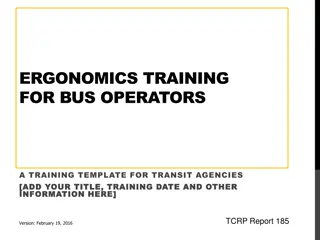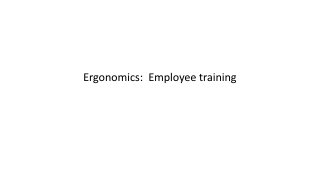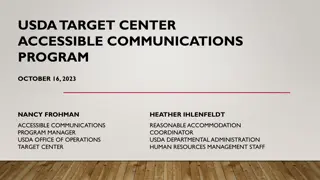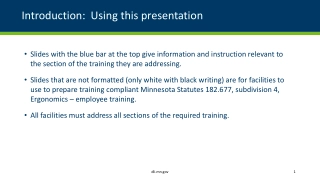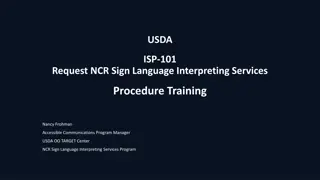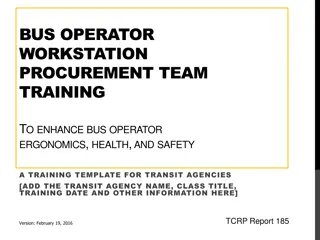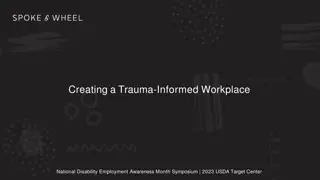USDA TARGET CENTER ERGONOMICS PROGRAM
Workplace ergonomics and the USDA TARGET Center's program for improving workplace health and productivity. Understand risk factors, prevention principles, and resources available for ergonomic support.
- workplace ergonomics
- musculoskeletal disorders
- prevention
- ergonomic evaluation
- resources
- productivity
- health
Download Presentation

Please find below an Image/Link to download the presentation.
The content on the website is provided AS IS for your information and personal use only. It may not be sold, licensed, or shared on other websites without obtaining consent from the author. Download presentation by click this link. If you encounter any issues during the download, it is possible that the publisher has removed the file from their server.
E N D
Presentation Transcript
United States Department of Agriculture TARGET Center USDA TARGET CENTER ERGONOMICS PROGRAM Stephanie Bradley Ergonomics Program Manager
TODAYS PRESENTER Stephanie Bradley, CAE, CEAS Ergonomics Program Manager Sl.Bradley@usda.gov 202-720-2600 USDA Office of Operations TARGET Center
LEARNING OBJECTIVES Understand the science of workplace ergonomics and the USDA TARGET Center s workplace improvement processes. Identify the common risk factors associated with work-related musculoskeletal disorders, prevention principles and how to adopt proper mechanics. Increase self-awareness of early discomfort and the signs of musculoskeletal disorders and understand the steps to establish an ergonomic evaluation for USDA employees nationwide at the USDA TARGET Center Ergonomic Program. Identify the necessary resources available at the USDA TARGET Center and determine how the TARGET Center can provide support within education, identification of ergonomic equipment, and facilitation of product loans for USDA employees nationwide. USDA Office of Operations TARGET Center
HISTORY OF ERGONOMICS AT THE TARGET CENTER The TARGET Center s Ergonomic Program started in 1992 to support employees that needed support with obtaining an ergonomic chair. A collaboration between a prominent chair vendor was established once it was identified the need for ergonomic chairs for many government employees that have Musculoskeletal Disorders. This prominent chair vendor setup a weekly chair fittings which provides custom chairs to support government employees that have disabilities. Thus, the Ergonomic Program at the TARGET Center has been successful in fitting thousands of employees with the appropriate ergonomic chair. USDA Office of Operations TARGET Center
ERGONOMICS: WHAT IS IT? Definition: Ergonomics is the science of fitting the job to the worker. Designing workstations and tools to reduce work-related musculoskeletal disorders (MSDs) can help workers stay healthy and companies to reduce or eliminate the high costs associated with MSDs. Strategy: Ergonomics considers the physical and mental capabilities and limits of the worker as he or she interacts with tools, equipment, work methods, tasks, and the working environment. Goal: Reduce work-related musculoskeletal disorders (WMSD s) by adapting the work to fit the person, instead of forcing the person to adapt to the work. USDA Office of Operations TARGET Center
ERGONOMICS: WHY IT MATTERS? Ergonomics prevents injury of workers!!! Musculoskeletal disorders are preventable and unnecessary injuries: Cost the US economy billions of dollars annually Result in missed work, increased pain, and decreased morale among affected workers. Integrating good ergonomics into job and workplace design costs no more than choosing a bad design. Ergonomics programs focus on ways to reduce costs to companies by: - reducing injuries - reducing errors - reducing absenteeism - maximizing productivity USDA Office of Operations TARGET Center
WHAT ARE MUSCULOSKELETAL DISORDERS (MSDS)? Illnesses and Injuries of the musculoskeletal system that can have a work- related casual component include: - Sprains - Tears - Strains - Pinched nerves or blood vessels - Inflammation - Stress fractures - Degeneration *29% of all workplace injuries in the U.S. requiring time away from work are caused by work-related MSDs USDA Office of Operations TARGET Center
RISK FACTORS ASSOCIATED WITH MUSCULOSKELETAL DISORDERS Repetitiveness and pace of work Work postures and movements Force of movements Vibration Temperature USDA Office of Operations TARGET Center
WORK POSTURES AND MOVEMENT ERGONOMICS: AWKWARD POSTURE Awkward posture refers to positions of the body that deviate significantly from the neutral position while performing work activities. When you are in an awkward posture, muscles operate less efficiently, and you expend more force to complete the task. Examples of awkward postures are twisting, bending, reaching, pulling or lifting. USDA Office of Operations TARGET Center
REPETITIVE MOTIONS Repetitive Motion Disorders (RMDs) are a family of muscular conditions that result from repeated motions performed during normal work or daily activities. The disorders are caused by too many uninterrupted repetitions of an activity or motion, unnatural or awkward motions such as twisting the arm or wrist, overexertion, incorrect posture, or muscle fatigue. RMDs Include: Carpal tunnel syndrome Bursitis Tendonitis Epicondylitis Ganglion cyst Tenosynovitis Trigger finger RMDs occur most commonly in the hands, wrists, elbows, and shoulders, but can also happen in the neck, back, hips, knees, feet, legs, and ankles. USDA Office of Operations TARGET Center
FORCE OF MOVEMENTS Excessive force is one of the primary ergonomic risk factors. Many work tasks require high force loads on the human body. Muscle effort increases in response to high force requirements which increases fatigue and risk of an MSD. There are numerous conditions that affect force, but the idea is to recognize when a job or task requires excessive force and then find ways to reduce that force. Eliminating excessive force requirements will reduce worker fatigue and the risk of MSD formation in most workers. Using the following will help to reduce these risks: Mechanical assists Counterbalance systems Adjustable height lift tables and workstations Powered equipment Ergonomic tools USDA Office of Operations TARGET Center
VIBRATION Occupational vibration exposure occurs when the body is exposed to pulsation, shaking or tremors usually produced by a vibrating object such as a power hand tool. Vibration is often called a vector quantity, which means that the vibratory motion has both a negative effect in of itself and a magnitude or intensity component. Vibration restricts the blood supply to the hands and fingers, which, depending on the vibration level and duration of exposure, can contribute to an ergonomic injury. Vibration exposure is separated into hand-arm vibration (HAV) and whole- body vibration (WBV). These two types of vibration have different sources, affect different areas of the body and produce different symptoms. USDA Office of Operations TARGET Center
VIBRATION (CONT.) HAV (hand-arm vibration) is usually caused by a vibrating hand tool or work piece which transmits the movement. WBV (whole-body vibration) is usually felt when sitting or standing on a vehicle or machine, travelling over rough ground or along a track. USDA Office of Operations TARGET Center
TEMPERATURE Extreme temperatures can cause various problems for workers. Problems may include trouble breathing, fatigue, reduced dexterity, sensory sensitivity and reduced grip strength. Hot temperatures can lead to dehydration and muscle fatigue, especially in conjunction with high humidity. Cold temperatures make the muscles less flexible, resulting in muscle strains and pulls. Hot or cold work environments do not necessarily need to be outdoors. Any location that is outside of the typical comfort zone of 55 - 85 degree Fahrenheit is cause for concern. USDA Office of Operations TARGET Center
WHAT KIND OF INJURIES ARE MUSCULOSKELETAL DISORDERS Acute Injuries Happen immediately due to overload Can become chronic Re-injury possible Strains, sprains, disc herniations Musculoskeletal Chronic Injuries Pain or symptoms lasting more than a month Cumulative Trauma Happen over time Difficult to cure USDA Office of Operations TARGET Center
COMMON WORKPLACE INJURIES Carpal Tunnel Syndrome De Quervain s Disease Hand & Wrist Tendonitis Epicondylitis Elbow Musculoskeletal Rotator Cuff Tendonitis Thoracic Outlet Syndrome Shoulder Tension Neck Syndrome Neck Disc Herniation Back Pain/Sprain Back USDA Office of Operations TARGET Center
CARPAL TUNNEL SYNDROME (CTS) The carpal tunnel is composed of eight irregular shaped carpal bones covered by the tough fibrous flexor retinaculum which contains the finger flexor tendons and the median nerve. Median nerve innervates most of the palm, thumb, index finger, middle finger, and radial border of the ring finger. Causes Flexor tendon sheaths that become swollen may impinge on the median nerve within the cramped carpal tunnel. Symptoms Numbness Tingling pain in the distal distribution and may commonly wake patients during the night. *In advanced cases, symptoms may persist during the day, person may drop objects frequently owing to decreased sensation, and linear muscle atrophy. USDA Office of Operations TARGET Center
DE QUERVAINS DISEASE A form of tenosynovitis affecting the first dorsal (extensor) compartment of the hand. The sheath of the tendons on the thumb side of the wrist become inflamed or swollen, making it difficult to move. Symptoms: dull aching sensation over the tendon discomfort with specific movements, grasping or turning wrist tenderness to touch USDA Office of Operations TARGET Center
ELBOW TENDONITIS Also known as tennis elbow , affecting the outer part of the elbow. Inflamed unsheathed tendon that may become frayed or torn apart when repeatedly exerted and tensed. Could become thickened, bumpy, and irregular. Tendons without sufficient rest and recovery time may become permanently weakened. Causes May be caused by repetitive motions which aggravate the tendons needed to perform the task. Symptoms includes a dull aching sensation over the tendon discomfort with specific movements tenderness to touch USDA Office of Operations TARGET Center
EPICONDYLITIS Also known golfers' elbow, affecting the inner part of the elbow. This is another form of tendonitis affecting the wrist and digit flexors where they originate at the medial epicondyle of the elbow. Causes May be caused by excess or repetitive motions in the wrist and fingers ( such as typing), or a sudden force to the elbow or wrist. Symptoms includes a dull aching sensation over the tendon discomfort with specific movements tenderness to touch USDA Office of Operations TARGET Center
SIGNS AND SYMPTOMS OF MSDS Early Warning Signs: Numbness of burning sensation in hand Reduced grip strength in the hand Swelling or stiffness in the joints Pain in wrists, forearms, elbows, neck or back Reduced range of motion in the shoulder, neck, or back Dry, itchy, or sore eyes Blurred or double vision Aching or tingling Cramping Weakness These signs and symptoms should be reported to the physician and ergonomic evaluation should be made. USDA Office of Operations TARGET Center
ERGONOMIC ADJUSTMENTS TO PREVENT MUSCULOSKELETAL DISORDERS Fortunately, with early intervention and improved work & task design, MSDs can be prevented. Here are a few strategies you can use throughout your day to avoid discomfort and prevent injury: Take frequent breaks get up and stretch, walk around or change your scenery. Vary the workday if possible, try to space out different types of tasks. When using a computer, follow the 20-20-20 rule - every 20 minutes, look at something about 20 feet away for at least 20 seconds. Report pain or discomfort immediately don t wait until it becomes serious, always inform your supervisor. If you are a supervisor, be sure to monitor your employees and make sure they are taking necessary breaks. USDA Office of Operations TARGET Center
TARGET CENTER ERGONOMIC SERVICES RESOURCES EVALUATIONS CHAIR FITTINGS USDA Office of Operations TARGET Center
ERGONOMIC RESOURCES 1. The USDA TARGET Center Ergonomic loan program provides a variety of ergonomic equipment so that employees can test out equipment in preventing workplace injuries. 2. Demonstrations of ergonomic equipment can be provided in allowing employees information on ergonomic equipment and how to utilize the equipment. 3. Webinar training is provided for all USDA employees to receive education on ergonomics and identify the proper setup in positioning ergonomic tools and properly setting up your workstation. USDA Office of Operations TARGET Center
Provide customers with Ergonomic loans to bridge a gap in time before customers have access to permanent solutions or for a temporary disability. ERGONOMIC LOAN PROGRAM Loans are for 30 days. Items will be shipped to customers. Not all Ergonomic equipment recommended is available for loan. USDA Office of Operations TARGET Center
Pre-Evaluation Form ERGONOMIC EVALUATION PROCESS Evaluation Meeting Report USDA Office of Operations TARGET Center
USDA EMPLOYEES Good News All USDA employees can obtain an evaluation!!! Complete a pre-ergonomic evaluation form on the USDA TARGET Center website. Submit digital pictures of yourself at your workstation, so the Ergonomics Program Manager can see the workstation setup and how you are utilizing equipment. Evaluation can be done In-Person or Virtually oIf located within the NCR (National Capitol Region) then you can obtain an evaluation In-Person at the TARGET Center. USDA Office of Operations TARGET Center
Ergonomic Evaluations are the first step to a more comfortable working environment. An ergonomic evaluation is a comprehensive assessment of your workstation, tools, and equipment. It provides detailed information about how you use your workplace, which can help you adjust and improve comfort as well as reduce stress on the job. Ergonomic evaluations are especially important for people who spend long hours at their jobs or have repetitive tasks that strain their bodies. Any USDA employee can benefit from an ergonomic evaluation if they are experiencing pain or discomfort as part of their daily routine or even as prevention. ERGONOMIC EVALUATION USDA Office of Operations TARGET Center
The TARGET Center Ergonomic Program partners with various vendors to help facilitate the acquisition process to obtain recommended ERGO products. VENDOR CONNECTIONS Vendors can provide quotes and work with agencies to ensure a smooth purchase process. USDA Office of Operations TARGET Center
SUMMARY 1. Musculoskeletal Disorders (MSDs) are illnesses and injuries of the musculoskeletal system that can have a work-related casual component. 2. The goal of ergonomics is to minimize work-related MSD s by adapting the work to fit the person, instead of forcing the person to adapt to the work. 3. Symptoms of MSD s involve swelling, numbness, tingling, discomfort, burning sensation, irritation, stiffness, pain and weakness. 4. TARGET Center and the Ergonomic resources available to prevent Musculoskeletal Disorders at your workstation. USDA Office of Operations TARGET Center
UPCOMING WORKSHOP Ergonomics Program Demonstration Tuesday, 10/12/23 USDA Office of Operations TARGET Center
THANK YOU Share in Your Networks Access Webinars Collaborate with TARGET Center! Sign Up for Email List Request Ergo Evaluation Follow on Twitter Request Training
Current and Upcoming Meetings OCTOBER THURSDAY TUESDAY WEDNESDAY MONDAY 10/3/223 10/3/2023 10/2/2023 10/4/2023 10/5/2023 10:00AM 11:00AM Empowering Lives Through Assistive Technology Solutions Donny Osborn Boundless AT 11:00AM 12:00PM Nurturing Workplace Well-Being and Supporting Mental Health (Part 1 of 2) Dr. Theresa Haskins Haskins Consulting 11:00AM 12:00PM Rethinking Disability and What It Means to Be Disabled Dr. Theresa Haskins Haskins Consulting 10:00 AM 11:00AM USDA TARGET Center Assistive Technology Program Rashida Owens Assistive Technology Program Manager 12:00PM 1:00PM Department of Defense Computer/Electronic Accommodations Program (CAP) Erin Sanderson CAP 1:00PM 2:00PM (Neuro) Diversity Includes You Dr. Theresa Haskins Haskins Consulting 12:00PM 1:00PM USDA TARGET Center Ergonomics Program Stephanie Bradley CEAS, CAE Ergonomics Program Manager 1:00 PM 2:00PM PTSD Is More Common Than You Think Alla Weinberg Spoke & Wheel HOLIDAY 10/10/2023 10/11/2023 10/12/2023 11:00AM 12:00PM Autism Inclusion and the Pathway to Neurodiversity Dr. Theresa Haskins Haskins Consulting 10:00 AM - 12:00 PM USDA TARGET Center Ergonomics Demonstrations (Virtual/Onsite) Stephanie Bradley CEAS, CAE Ergonomics Program Manager Stephen DiCarlo Humanscale Howard Flowers BodyBilt 11:00 AM 12:00PM Creating a Trauma-Informed Workplace Alla Weinberg Spoke & Wheel 1:00PM 2:00PM Lessons from Unpredictable Journeys: Insights from Temporary and Situational Disabilities (Part 1 of 2) Dr. Theresa Haskins Haskins Consulting 1:00PM 2:00PM Nurturing Workplace Well-Being and Supporting Mental Health (Part 2 of 2) Dr. Theresa Haskins Haskins Consulting 1:00 PM - 3:00 PM USDA TARGET Center Assistive Technology Demonstrations (Virtual/Onsite) Rashida Owens Assistive Technology Program Manager
TARGET CENTER CONTACT INFORMATION TARGET Center Website https://www.targetcenter.dm.usda.gov TARGET Center Email target-center@usda.gov TARGET Center Phone Number (202) 720-2600


